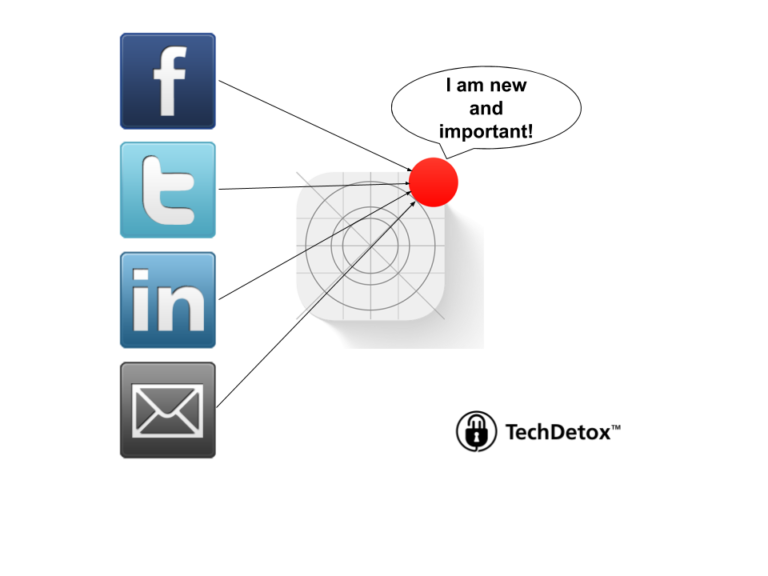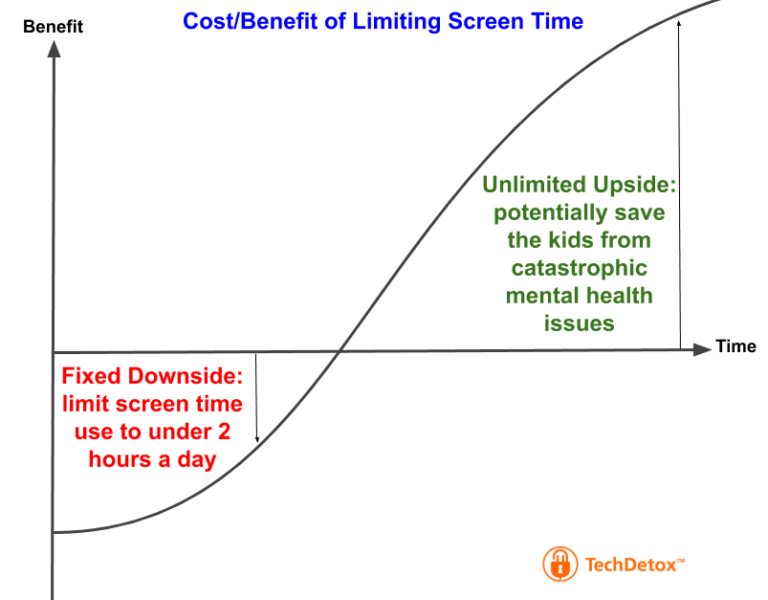
How Phones Hack Our Brains: Anatomy of a Notification
Do we pick up our phone hundreds of times per day out of our own free will? We think we do. But app designers know better. This “new normal” human behavior was created by design.
No one likes to be manipulated. We think our attention to our devices is freely given when in fact it is skillfully extracted.
It’s an open secret that humans can be hacked.
Our prehistoric brains’ collection of cognitive biases is essentially the same for everyone. No matter how smart we think we are, we cannot overcome our biology.
Digital media developers that can tap into human neurological weaknesses can achieve higher “user engagement” most effectively. Which in today’s attention economy means money. The main purpose of the business becomes to get you to pick up that phone and stare at it as long as possible.
What is a notification and what does it do?
- It’s a buzz from your phone.
- It’s a red circle notifying you of the new activity within an app.
- It’s a pop-up calling you to some form of action.
- It’s anything that distracts you from your current activity and demands that you switch your attention to IT. Immediately.
Let’s take a look at the neurological storm that a simple notification unleashes in our brain.
Notification is a Change of Environment
Our brains are biologically the same they were 50,000 years ago. When our ancestors roamed the savanna, a change in the environment – like a sudden noise – could mean you are about to be eaten by a sabre-tooth tiger.
You either paid attention, or exited the gene pool.
Notification exploits Zeigarnik effect
Zeigarnik effect is a cognitive bias that makes us remember incomplete tasks better than finished ones.
A notification creates a new “to-do” item in the back of your head that screams “Unfinished business!”
Which makes it impossible to concentrate on other priorities. It will occupy your mental real estate until you deal with it and check it off the list.
A bonus side effect: given the exponentially growing list of these “micro-tasks” on everyone’s agenda, we are spending all of our time in a state of low-grade anxiety.
Notification is a Slot Machine of Random Rewards
We are motivated by random rewards more than by predictable outcomes.
That’s why a surprise gift or party is so fun. That’s why slot machines are so addictive – and so profitable for the casino. The reward centers of our brain love to be surprised. As we stare at the notification, we become instantly curious and excited: what awaits me behind that red circle?
- A message from a friend?
- A like to my photo or post?
- A scandalous news update?
- A cute cat video?
- A juicy piece of gossip?
- An advertisement?
- Any distraction from the work I don’t feel like doing?
There is no way to find out but to open the app. And spend the next minutes or hours of your life making money for its creators.
Notification is an Instrument of Social Validation
We have evolved as deeply social beings, depending on social cues from our fellow tribe members for survival. Throughout human history to ignore social cues would be life-threatening. We look to other people to confirm our decisions and our very self-worth.
This social biology of the brain has been digitized into “likes” and “follows”.
I have a social media update – somebody is interested in me! I have to check – my brain tells me it’s critical to my place in society!
Add social pressure to reply immediately or reciprocate the “like” from a friend, and you get…traffic.
Which translates into dollars.
Notification Creates an Illusion of Progress
When we react to a notification, we get a feeling of having accomplished a task while in reality we only accomplished a distraction.
Most likely from deep meaningful (and paid) work, giving us an excuse to procrastinate – dozens of times per day, effectively destroying our productivity.
We are all vulnerable to distractions, but some people are especially susceptible. For example, children with ADHD have no ability to resist digital interruptions that derail their education.
Notification Exploits Loss Aversion
We would rather avoid losses than acquire equivalent gains.
That would be your classic FOMO – the Fear of Missing Out. What if I lose an important piece of information or a valuable opportunity by not immediately checking what that notification is all about?!
Notification Exploits Salience Bias
We focus on items that are more noticeable. Things that stand out. We make them a priority without thinking about it consciously.
It’s the primary evolutionary mechanism of attention and survival.
There is a reason that those notification circles are red – the color of danger.
Notification Exploits Restraint Bias
People overestimate their ability to control impulsive behavior. We believe we have enough self-control to use technology responsibly, but in fact our ability to resist its temptations is much lower than we imagine.
Grabbing the phone is an impulse. Tech industry worked hard to make sure this behavior is automatic.
They don’t want you to stop and think. You might change your mind.
Notification Exploits Attentional Bias
Attentional bias has long been studied in addictive behavior. For example, when smoking cues are present in the environment it is harder for a smoker to concentrate on anything else.
If a buzzing phone is right in front of you, your attentional bias will not let you resist the temptation.
There are probably more features in our neurobiology that can be hacked by a simple notification, these are just the more obvious ones. The implications are clear.
Our attention that powers a multi-trillion dollar data industry is not freely given. It is taken from us whether we want it or not.

Once we bite, they reel us in with a host of sophisticated persuasive design techniques. To make us spend the majority of our waking hours on the screens, making money for the industry that turned humans into data. Paying for it with the time of our short life that we can never get back.
By the end of the day you are overwhelmed, distracted, stressed for having accomplished little of value because of constant interruptions. Your well-being is compromised. Only the creators of the apps that sent you those notifications don’t care about your well-being – they care about their profit. It’s just business, nothing personal.
What can we do about this?
Solution #1: Use the Science of Habits
Fight back with the same weapons tech developers used to manipulate human behavior. The science of habits building can be used both ways: replacing bad digital impulses that were intentionally “built-in” into us as an automatic response (constantly checking the phone) with good digital habits of YOUR choice.
Great books on the subject:
Tiny Habits: The Small Changes That Change Everything, by BJ Fogg
Professor Fogg of Stanford Persuasive Technology Lab is the researcher of the many persuasive design techniques tech companies use against us – who is better to teach people how to overcome them?
Atomic Habits: An Easy & Proven Way to Build Good Habits & Break Bad Ones, by James Clear
Great practical strategies on how to form good habits and break bad ones – including digital distraction.
Solution #2: Turn Notifications Off
If it’s not a real person but a manipulative algorithm trying to reach you, you do not need a notification – turn them off.
Solution #3: Batch digital activities
Check email, messaging apps, any tools that you use to communicate with people in your professional and personal life at predetermined intervals. Twice a day, in the morning and in the evening, or what works best for your schedule. Not every 5 minutes.
Assign a time to check your social media, YouTube, or anything else that falls in the leisure and entertainment category to the end of the day when all important work is done and your attention has been given to the real world activities and relationships.
Great book on the subject:
Digital Minimalism: Choosing a Focused Life in a Noisy World, by Cal Newport
Solution #4: Remove the biggest offenders
YouTube, Netflix, Facebook, Instagram, video games – remove these apps from your phone and use them on another device at the time and place of your choosing.
Every time-sucking app is a direct line to your attention, like a needle in your vein.
Pull it out.
Solution #5: Put distance between you and your phone
When you don’t want to be distracted, the phone should be in another room – not by your side, not in your pocket.
Solution #6: Know yourself better than AI knows you
This is probably the most important solution of all.
The best screen time management filter is the one between your ears.
If the algorithms of Artificial Intelligence know us better than we know ourselves, they can manipulate our behavior. Depriving us of our free will without us noticing. Pressing psychological buttons we don’t even know we have.
But if we can recognize when and how we are being manipulated, we can say no.
You Shall Know the Truth and the Truth Shall Make You Free.
Take Back Control
Sign up for our monthly newsletter to receive latest digital wellbeing research and screen time management solutions. We never share your email with third parties.Share this:
- Click to share on X (Opens in new window) X
- Click to share on Facebook (Opens in new window) Facebook
- Click to share on LinkedIn (Opens in new window) LinkedIn
- Click to share on Pinterest (Opens in new window) Pinterest
- Click to email a link to a friend (Opens in new window) Email
- Click to print (Opens in new window) Print







